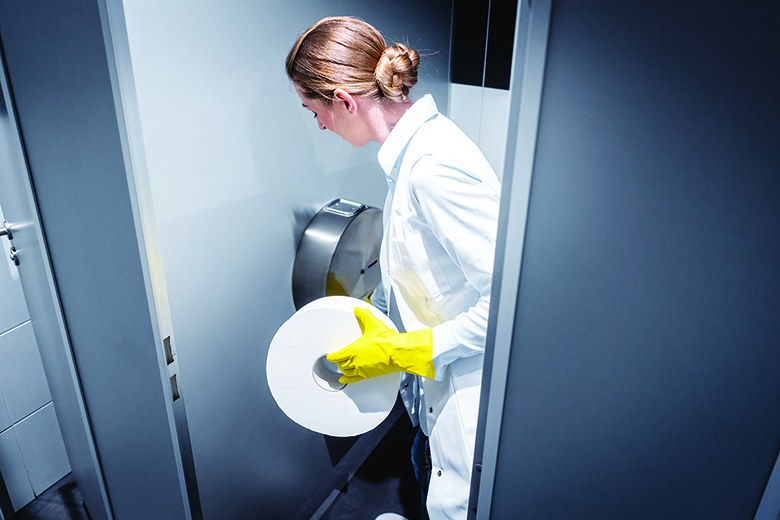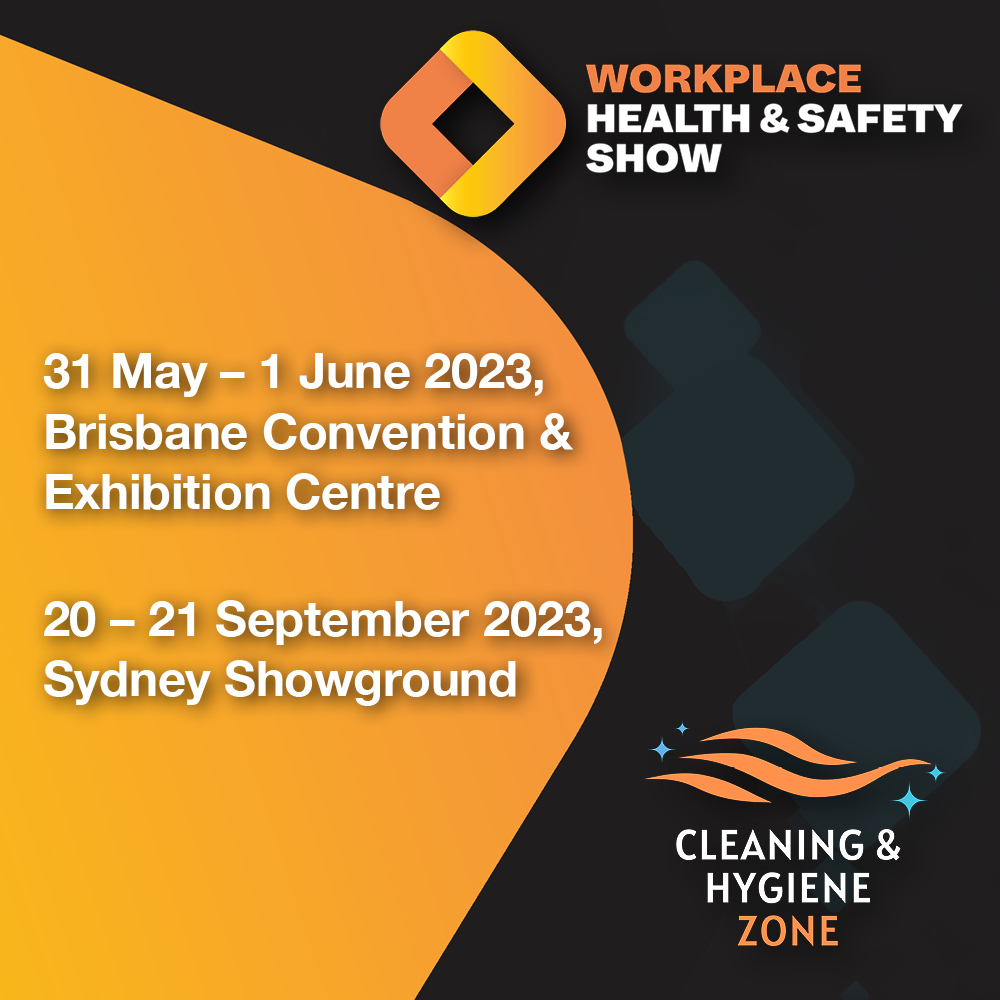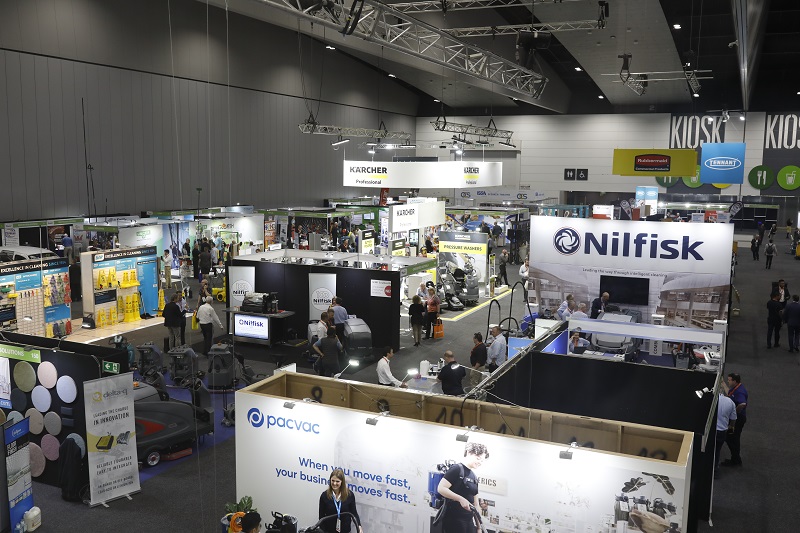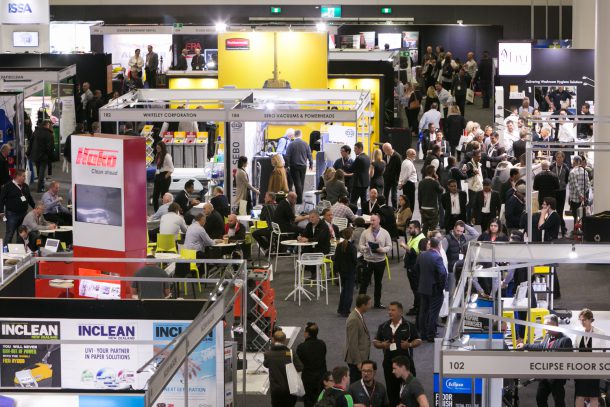
The latest technology and product trends have the potential to improve restroom cleaning and hygiene standards while also delivering productivity, budgetary and sustainability benefits for facility managers.
The days of cleaners signing off on paper inspection charts on the back of a restroom door seem to be numbered as transformative technology shakes up the space.
With artificial intelligence and smart sensors available for use to monitor restroom activity and cleanliness, facility managers, and cleaning contractors can draw from rich data to improve hygiene outcomes.
Martin Tofts, national key account manager – facilities management at Bunzl Australia and New Zealand, expects AI and data analytics to become commonplace in restrooms in years to come, leading to superior hygiene standards and the more efficient deployment of cleaning staff.
“There’s no point having five cleaners on level five of a commercial building during lunchtime when everyone’s in the food court and restrooms need cleaning,” he says.
Tofts believes such AI and data integration will especially come to the fore in restrooms in hospitals and healthcare facilities, but other sites such as airports and retail outlets are also likely to be technology adopters. Productivity gains from data analysis have the potential to offset any associated technology costs.
“You might have a modest outlay at the start, but if you can save having cleaners going into restrooms every five minutes to make sure the dispensers are full, you’re going to save money in the long run,” Tofts says.
Cost cuts in favour
More than three years after the start of the pandemic, some facility managers are switching their focus back to cost management, rather than hygiene practices.
Lucas Paris, managing director of cleaning machine manufacturer MotorScrubber, says price is again top of mind for facility managers as they strive to achieve good cleaning and hygiene results without blowing the budget.
“Yes, people want to be perceived as still having a high level of clean after COVID-19, but are they investing in the approved disinfectants and sanitisers?” he asks.
“Are they going through the misting cycles that they were 18 months ago? No.”
Paris says many customers simply cannot justify spending $30,000 to $40,000 on a floor scrubber when another machine can get the job done for a quarter of the price.
This cost reality check has convinced MotorScrubber to focus on engineering fit-for-purpose cleaning machines – those that perform well without being overly expensive. The company’s new compact scrubber, called SHOCK, is set for its Australian release later this year and is designed for “detail cleaning” of floors, stairs, baseboards, and walls.
Paris says one of the keys to the machine’s popularity is that it has the lowest profile cleaning head in the world, making it ideal for access-all-areas cleaning in restrooms, “whether you’re in a small toilet in a country footy ground or at a high-end hotel in the Melbourne or Sydney CBD”.
MotorScrubber is also finalising the development of a new machine, the Dryft, which it bills as the world’s fastest floor-cleaning machine for small and medium-sized areas.
Voan Biclar, product category manager, washroom at Bunzl, agrees that in the current market “there really is an appetite to try to save”. She adds that for suppliers there is “alot ofquoting” at the moment.
“We’re getting a lot of people who are going out to market trying to get cost reductions because they have had to endure significant cost increases during the last three years.”
In such a volatile product and pricing market, Biclar advises facility managers to conduct a robust re-evaluation of their spending and inventories in the knowledge that, in some cases, they may be “over-specing”.
“For example, when I go into public places and restrooms I sometimes think, ‘Wow, they’re providing a really high-quality paper towel – it’s probably over-speced for this environment.”
With restroom dispensers, Biclar warns that some of the major global manufacturers are rolling out proprietary dispensers that can only fit their specific product lines. This potentially locks facilities into a particular supplier, which can cause problems at a time when supply chains are still less reliable than before the pandemic.
“What we found during the pandemic is that if there is a supply issue, facilities may not be able to get their regular products,” Biclar says.
“But if you have the flexibility and option of generic products, this could help you in the long run.”
Affordability the key
Some other product manufacturers are following suit in the quest for effective, affordable machines and equipment. Lorenzo Tadeo, the marketing director in the professional division of Freudenberg – whose brands include Oates, Vileda Professional and Research Products – says in the past decade there has been stiff competition among manufacturers to launch the “most durable mop” for restroom and other high-traffic areas. Capable of anywhere from 500 to 700 washes, they typically are expensive to buy and maintain the cleaning pads.
“One of the problems is that you have a lot of losses in situations where you give the cleaners 20 mops in the morning and you get back just 15,” Tadeo says.
“That’s quite an investment and you also have high costs in the laundry.”
In response, the Oates brand is seeking to offer affordable products that clean well and last, including its Ultimate Duo mop, which has been developed with humid and bacteria-heavy restrooms in mind. The mop glides easily over anti-slip or safety floors without leaving behind fibres that contribute to contamination problems.
Tadeo notes that flooring is measured according to a slip-resistance rating on a scale from R9 (low slip resistance) to R13 (high slip resistance), with restrooms typically requiring an R11 or R12 rating.
“This mop has been successful in that environment, and it balances the benefits of performance and durability. That means customers don’t have to be concerned about investing too much money in mops that can be lost. They are easy to wash and at the same time they clean well.”
Sustainability and packaging on the agenda
Sustainability is another key area for facility managers and suppliers as they service restrooms and other sites.
Bunzl is committed to running a sustainable operation and constantly reviews and improves its sustainability objectives. Among its latest initiatives, the company is seeking to get even smarter with its packaging.
For instance, it is eliminating the plastic collar in its Pristine line of tissue boxes, which it says has resulted in about 1200kg of plastic being eliminated from tissue boxes across Australia and New Zealand each year. With its Kwikmaster 3DHex heavy-duty wipes, it has redesigned the wrap to use less plastic.
Biclar says “everything is on the table” in Bunzl’s discussion of products with manufacturers and suppliers. “We’re not only looking at where products are sourced, but also at different ways to optimise our efficiency with the packaging and reduce plastic in the products.”
For its part, the Freudenberg group has committed to a 2025 goal of producing half of its packaging from recycled material. By that year at the latest, all packaging should then be recyclable, reusable or compostable. “We are really looking at sustainability every time we do something,” Tadeo says.
Since the 1990s, the group has also avoided using questionable materials such as PVC, turning to a more suitable plastic, PET, for its microfibre cloths and broom bristles.
Tadeo says the company’s wants to take the lead on sustainability and help inform customers on more sustainable practices.
Watch this space
As the cleaning world evolves, Paris has no doubt that there will be more room for innovation and R&D in areas such as robotics, especially in hygiene-critical environments such as healthcare restrooms.
“Once the technology becomes cheaper, the adoption rate will go up,” he says.
Crucially, though, it will have to be “tangible for an end user”.
“If I’m a facility manager contractor and I’ve got a walk-behind 60-litre scrubber and I get presented a wonderful robotic scrubber that’s 10 times the price with an ongoing service component that’s 5 per cent of the cost value over a three-year contract, that’s problematic. It’s great to have the innovation, but what does that mean practically for me on site if it’s not going to give me a better ROI?”
While he may argue about the best option to get a great clean, Paris has no doubt that investing in cleaning and hygiene, especially in restrooms, is crucial for reputational management.
“It’s a cheap way to make an impact on your customer and end user. If you go into a washroom that’s clean, whether it’s a fast-food outlet or high-end hotel, a small investment for a high-level clean can be achieved.”



